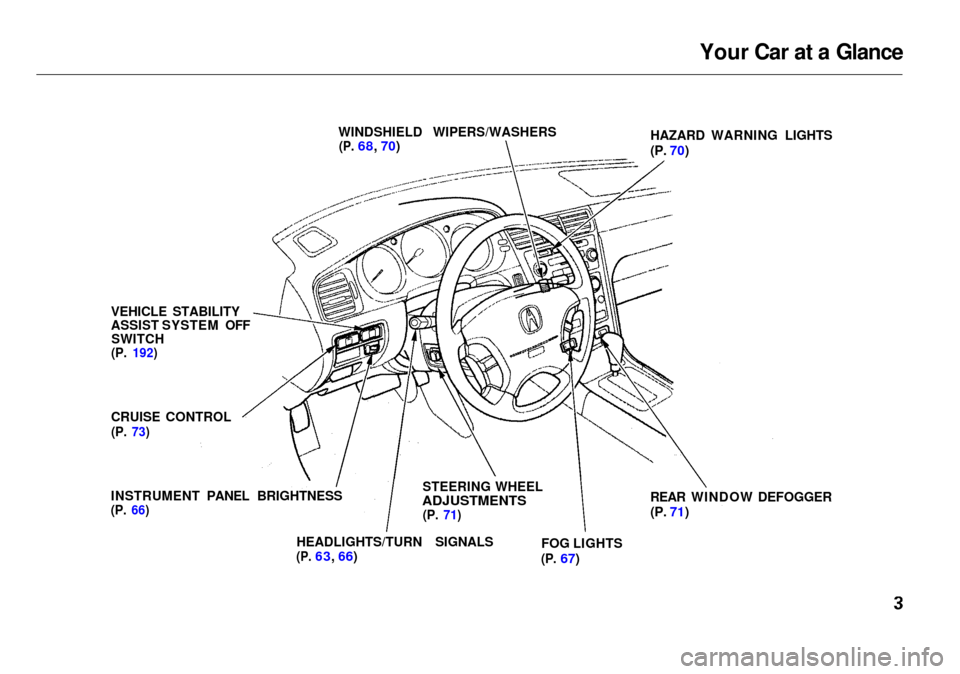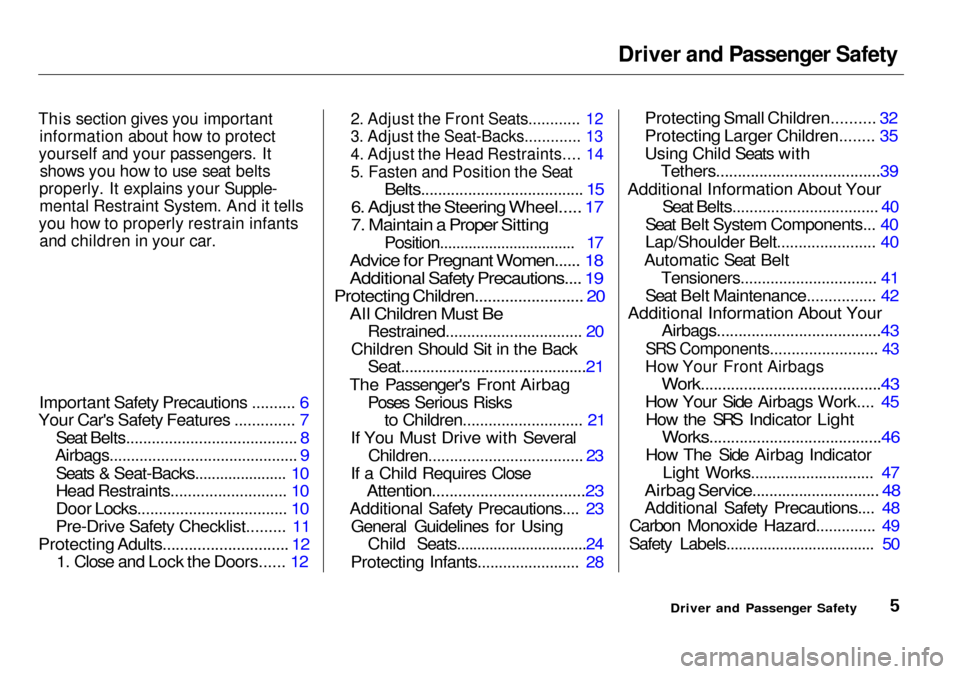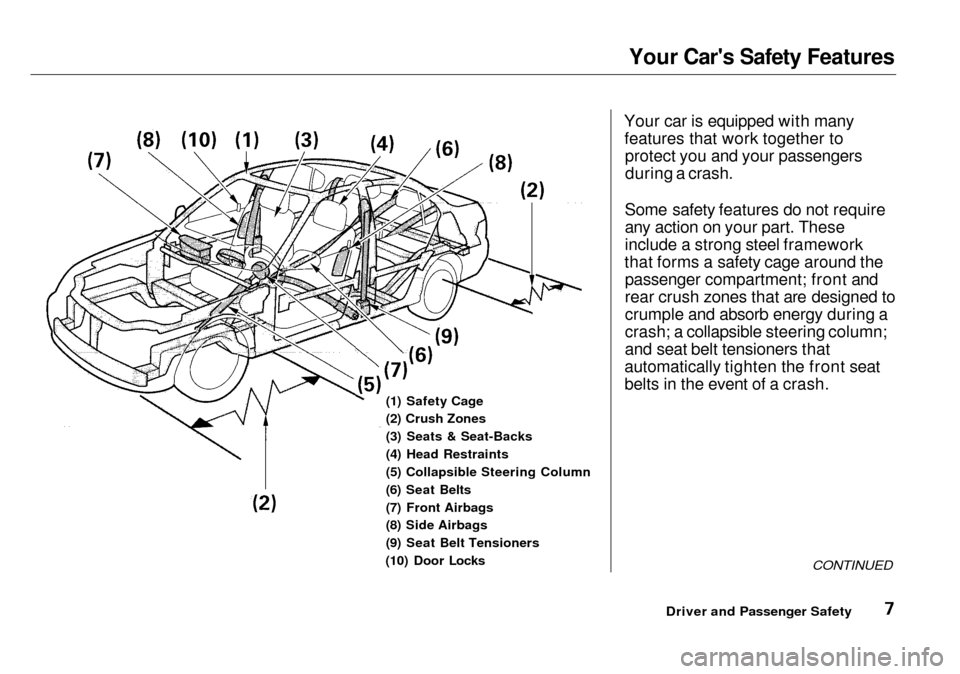steering Acura RL 2001 3.5 Owner's Manual
[x] Cancel search | Manufacturer: ACURA, Model Year: 2001, Model line: RL, Model: Acura RL 2001Pages: 333, PDF Size: 4.28 MB
Page 1 of 333

2001 RL Online Reference Owner's Manual
Use these links (and links throughout this manual) to navigate through\
this reference.
For a printed owner's manual, click on authorized manuals or go to www.h\
elminc.com.
Contents
Introduction ........................................................................\
................................................................. i
A Few Words About Safet y........................................................................\
.........................................ii
Driver and Passenger Safety ........................................................................\
..................................... .5
Proper use and care of your vehicle's seat belts, and Supplemental Restr\
aint System.
Instruments and Control s........................................................................\
........................................ .51
Instrument panel indicator and gauge, and how to use dashboard and steering colu\
mn controls.
Comfort and Convenience Features ........................................................................\
..................... 121
How to operate the climate control system, the audio system, and other c\
onvenience features.
Before Driving........................................................................\
..........................................................167
What gasoline to use, how to break-in your new vehicle, and how to load luggage and other cargo.
Driving ........................................................................\
..................................................................... .179
The proper way to start the engine, shift the transmission, and park, pl\
us towing a trailer.
Maintenance........................................................................\
.............................................................203
The Maintenance Schedule shows you when you need to take your vehicle to the dealer.
Appearance Car e........................................................................\
..................................................... .263
Tips on cleaning and protecting your vehicle. Things to look for if your\
vehicle ever needs body repairs.
Taking Care of the Unexpecte d........................................................................\
..............................271
This section covers several problems motorists sometimes experience, a nd how to handle them.
Technical Informatio n........................................................................\
.............................................299
ID numbers, dimensions, capacities, and technical information.
Warranty and Customer Relations (U.S. and Canada)................................................................313
A summary of the warranties covering your new Acura, and how to contact \
us.
Authorized Manu als (U.S. only)........................................................................\
..............................319
How to order manuals and other technical literature.
Index........................................................................\
........................................................................\
...... I
Service Information Summary
A summary of information you need when you pull up to the fuel pump.
Accord Value Package Audio System Owner's Identification Form
Your Vehicle at a Glance........................................................................\
............................................ 2
Page 6 of 333

Your Car at a Glance
WINDSHIELD WIPERS/WASHERS
(P.
68, 70) HAZARD WARNING LIGHTS
(P. 70)
VEHICLE STABILITY
ASSIST SYSTEM OFF SWITCH
(P. 192)
CRUISE CONTROL
(P. 73)
INSTRUMENT PANEL BRIGHTNESS
(P. 66)
STEERING WHEEL
ADJUSTMENTS
(P. 71)
HEADLIGHTS/TURN SIGNALS
(P.
63, 66) FOG LIGHTS
(P.
67)REAR WINDOW DEFOGGER
(P. 71)
Page 8 of 333

Driver and Passenger Safety
This section gives you important information about how to protect
yourself and your passengers. It
shows you how to use seat belts
properly. It explains your Supple-
mental Restraint System. And it tells
you how to properly restrain infants and children in your car.
Important Safety Precautions .......... 6
Your Car's Safety Features .............. 7
Seat Belts........................................ 8
Airbags............................................ 9
Seats & Seat-Backs...................... 10
Head Restraints........................... 10
Door Locks................................... 10
Pre-Drive Safety Checklist......... 11
Protecting Adults............................. 12
1. Close and Lock the Doors...... 12
2. Adjust the Front Seats............ 12
3. Adjust the Seat-Backs............. 13
4. Adjust the Head Restraints.... 14
5. Fasten and Position the Seat
Belts...................................... 15
6. Adjust the Steering Wheel..... 17
7. Maintain a Proper Sitting
Position................................. 17
Advice for Pregnant Women...... 18
Additional Safety Precautions.... 19
Protecting Children......................... 20
All Children Must Be
Restrained................................ 20
Children Should Sit in the Back
Seat............................................21
The Passenger's Front Airbag Poses Serious Risksto Children............................ 21
If You Must Drive with Several Children.................................... 23
If a Child Requires Close
Attention...................................23
Additional Safety Precautions.... 23 General Guidelines for Using Child Seats................................24
Protecting Infants........................ 28 Protecting Small Children.......... 32
Protecting Larger Children........ 35
Using Child Seats with
Tethers......................................39
Additional Information About Your
Seat Belts.................................. 40
Seat Belt System Components... 40
Lap/Shoulder Belt....................... 40
Automatic Seat BeltTensioners................................ 41
Seat Belt Maintenance................ 42
Additional Information About Your
Airbags......................................43
SRS Components......................... 43
How Your Front Airbags
Work..........................................43
How Your Side Airbags Work.... 45 How the SRS Indicator Light
Works........................................46
How The Side Airbag Indicator Light Works............................. 47
Airbag Service.............................. 48
Additional Safety Precautions.... 48
Carbon Monoxide Hazard.............. 49
Safety Labels.................................... 50
Driver and Passenger Safety
Page 10 of 333

Your Car's Safety Features
(1) Safety Cage
(2) Crush Zones
(3) Seats & Seat-Backs
(4) Head Restraints
(5) Collapsible Steering Column
(6) Seat Belts
(7) Front Airbags
(8) Side Airbags
(9) Seat Belt Tensioners
(10) Door Locks Your car is equipped with many
features that work together toprotect you and your passengersduring a crash.
Some safety features do not require
any action on your part. These
include a strong steel framework
that forms a safety cage around the passenger compartment; front and
rear crush zones that are designed to
crumple and absorb energy during a
crash; a collapsible steering column;
and seat belt tensioners that
automatically tighten the front seat
belts in the event of a crash.
CONTINUED
Driver and Passenger Safety
Page 13 of 333

Your Car's Safety Features
Airbags offer no protection in rear
impacts, rollovers, or minor
frontal or side collisions. Airbags can pose serious hazards.
To do their job, airbags must inflate with tremendous force andspeed. So while airbags help save
lives, they can cause minor injuries, or more serious or even fatal
injuries if occupants are not
properly restrained or sitting
properly.
What you should do: Always wear
your seat belt properly, and sit
upright and as far back as possible
from the steering wheel or
dashboard.
Seats & Seat-Backs
Your car's seats are designed to keep
you in a comfortable, upright position so you can take full
advantage of the protection offered
by seat belts and the energy absorbing materials in the seats.
How you adjust your seats and seat-
backs can also affect your safety. For example, sitting too close to thesteering wheel or dashboard
increases the risk of you or your
passenger being injured by striking
the inside of the car, or by an inflating airbag.
Reclining a seat-back too far reduces
the seat belt's effectiveness and increases the chance that the seat'soccupant will slide under the seat
belt in a crash and be seriously
injured.
What you should do: Move the front
seats as far back as possible, and
keep adjustable seat-backs in an
upright position whenever the car is
moving.
Head Restraints Head restraints can help protect you
from whiplash and other injuries. For
maximum protection, the back of
your head should rest against the center of the head restraint.
Door Locks
Keeping your doors locked reduces
the chance of being thrown out of
the car during a crash. It also helps prevent occupants from accidentallyopening a door and falling out, and
outsiders from unexpectedly opening
your doors.
Driver and Passenger Safety
Page 14 of 333

Your Car's Safety Features
Pre-Drive Safety Checklist
To make sure you and your passengers get the maximum
protection from your car's safety
features, check the following each
time before you drive away: All adults, and children who have
outgrown child safety seats, are
wearing their seat belts and
wearing them properly (see page
15).
Any infant or small child is
properly restrained in a child seatin the back seat (see page 20). Front seat occupants are sitting
upright and as far back as possible
from the steering wheel and dashboard (see page 12).
Seat-backs are upright (see page
13).
Head restraints are properly
adjusted (see page 14). All doors are closed and locked
(see page 12). All cargo is properly stored or
secured (see page 176). The rest of this section gives more
detailed information about how you
can maximize your safety.
Remember, however, that no safetysystem can prevent all injuries or
deaths that can occur in severe
crashes, even when seat belts are
properly worn and the airbags deploy.
Driver and Passenger Safety
Page 15 of 333

Protecting Adults
Introduction
The following pages provide instructions on how to properly
protect the driver and other adult
occupants.
These instructions also apply to children who have outgrown childseats and are large enough to wear
lap/shoulder belts. (See page 35 for important additional guidelines on
how to properly protect larger
children.)
1. Close and Lock the Doors
After everyone has entered the car, be sure the doors are closed and
locked.
Your car has a door monitor light on
the instrument panel to indicate
when a specific door is not tightly
closed.
For safety, locking the doors reduces
the chance that a passenger,
especially a child, will open a door
while the car is moving and accidentally fall out. It also reduces
the chance of someone being thrown
out of the car during a crash.
For security, locked doors can
prevent an outsider from
unexpectedly opening a door when
you come to a stop.
See page 81 for how to lock the
doors.
2.Adjust the Front Seats
Any driver who sits too close to the steering wheel is at risk of being
seriously injured or killed by striking
the steering wheel or from being struck by an inflating front airbag
during a crash.
Driver and Passenger Safety
Page 16 of 333

Protecting Adults
To reduce the chance of injury, wear your seat belt properly, sit upright
with your back against the seat, and
move the seat as far back as possible
from the steering wheel while stillmaintaining full control of the car.
Also make sure your front seat passenger moves the seat as far tothe rear as possible. Most shorter drivers can get far
enough away from the steering
wheel and still reach the pedals. However, if you are concerned about
sitting too close, we recommend that
you investigate whether some type of adaptive equipment may help.
Once your seat is adjusted correctly,
rock it back and forth to make sure
the seat is locked in position.
See page 94 for how to adjust the
front seats.
3.Adjust the Seat-Backs
Adjust the driver's seat-back to a comfortable, upright position,
leaving ample space between your
chest and the airbag cover in the
center of the steering wheel. If yousit too close to the steering wheel,
you could be injured if the front airbag inflates.
CONTINUED
Driver and Passenger Safety
Sitting too close to a front
airbag can result in serious injury or death if the front
airbags inflate.
Always sit as far back from the
front airbags as possible.
Page 20 of 333

Protecting Adults
6.Adjust the Steering Wheel
Adjust the steering wheel, if needed, so that the wheel points toward your
chest, not toward your face.
Pointing the steering wheel toward
your chest provides optimal protection from the airbag.
See page 71 for how to adjust the
steering wheel.
7.Maintain a Proper Sitting
Position
After all occupants have adjusted their seats and put on seat belts, it is
very important that they continue to sit upright, well back in their seats,
with their feet on the floor, until the
car is parked and the engine is off.
Sitting improperly can increase the
chance of injury during a crash. For
example, if an occupant slouches,
lies down, turns sideways, sits
forward, leans forward or sideways, or puts one or both feet up, the
chance of injury during a crash is
greatly increased. In addition, an occupant who is out of
position in the front seat can be seriously or fatally injured by
striking interior parts of the car, or
by being struck by an inflating front
airbag. Being struck by an inflatingside airbag can result in possibly
serious injuries.
CONTINUED
Driver and Passenger Safety
Sitting improperly or out of
position can result in serious
injury or death in a crash.
Always sit upright, well back in
the seat, with your feet on the
floor.
Page 21 of 333

Protecting Adults
Remember, to get the best
protection from your car's airbags and other safety features, you must
sit properly and wear your seat belt
properly.Advice for Pregnant Women
Because protecting the mother is the
best way to protect her unborn child,
a pregnant woman should always
wear a seat belt whenever she drives or rides in a car.
Remember to keep the lap portion of
the belt as low as possible across
your hips. Pregnant women should also sit
upright and as far back as possible
from the steering wheel or dashboard. This will reduce the risk
of injuries to both the mother and
her unborn child that can be caused
by a crash or an inflating airbag.
Each time you have a check-up, ask
your doctor if it's okay for you to drive.
Driver and Passenger Safety